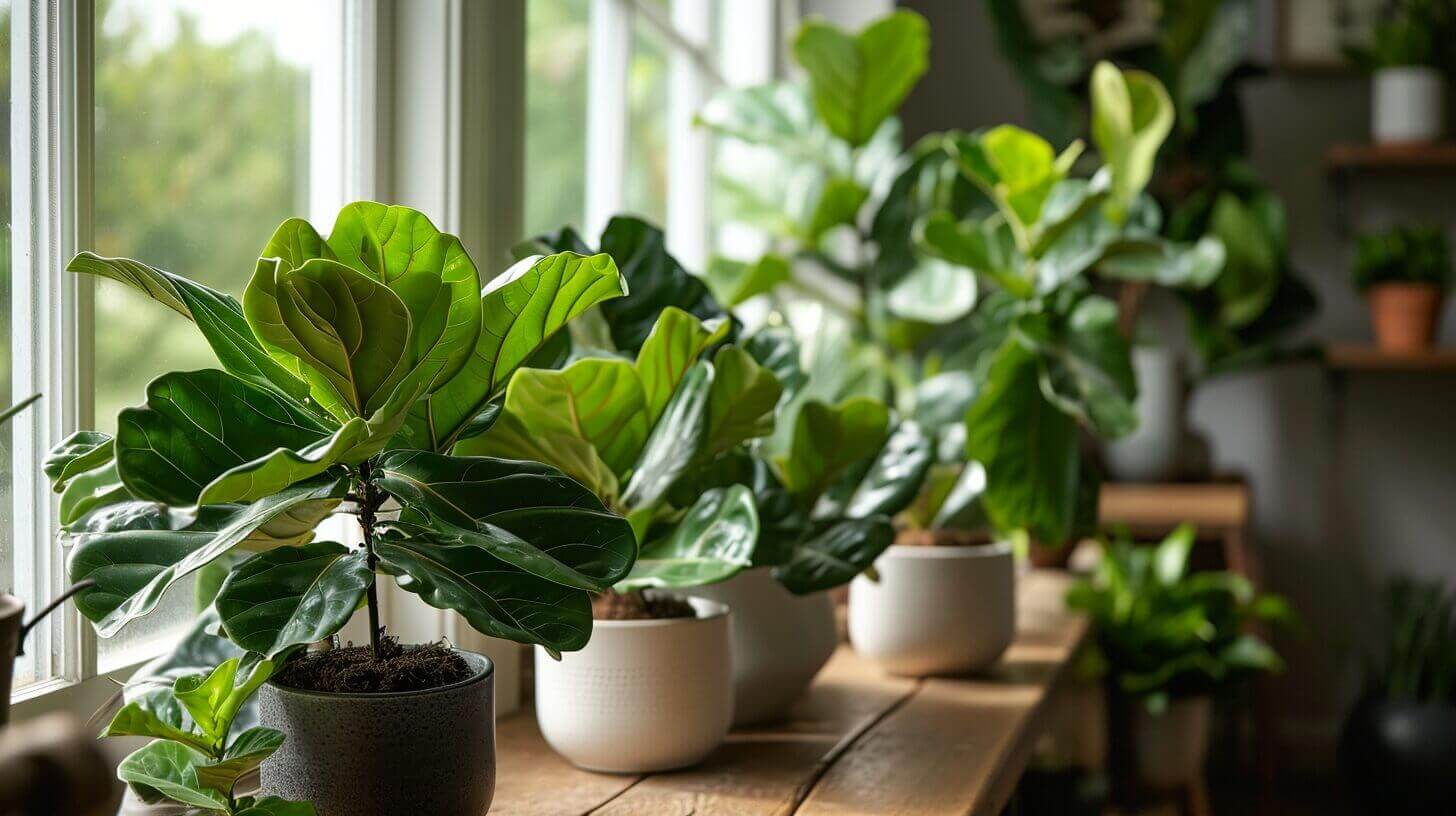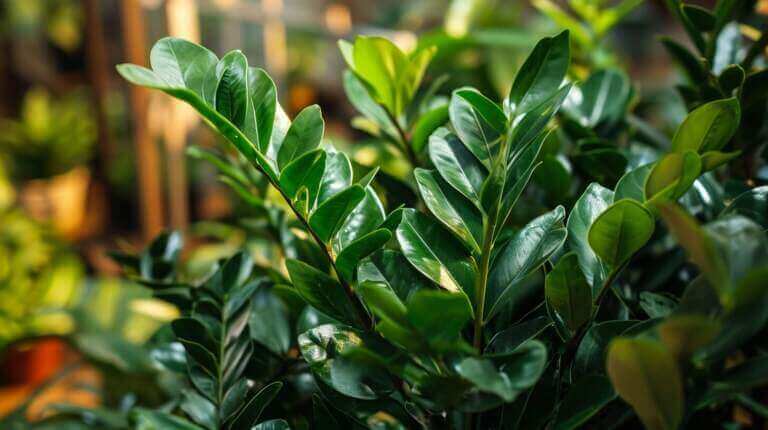How Much Light Fiddle Leaf Fig Tree Needs to Thrive? Understand Fiddle Leaf Fig Light Requirements
Fiddle leaf fig indoor plants are popular for their lush green foliage and striking appearance. To grow a healthy fiddle leaf fig tree, it’s important to understand its light requirements and provide the optimal conditions for its growth. In this article, I will guide you through the light needs of fiddle leaf figs and share valuable tips for their care.
Key Takeaways:
- Fiddle leaf fig plants require plenty of natural light to thrive.
- Placing them in front of a large south-facing window or a west-facing window can provide sufficient light.
- Observing the shadows cast by your hand or using a light meter can help determine the amount of light your plant receives.
- If your fiddle leaf fig shows signs of insufficient light, such as yellowing leaves or leggy reaching branches, it needs more sunlight.
- Artificial light can be used to supplement natural light, with fluorescent or LED lights being the best options.
Signs Your Fiddle Leaf Fig Needs More Sunlight
Fiddle leaf fig plants are known for their love of bright, natural light. If your fig isn’t getting enough light, it may start showing some signs of distress. Here are a few indicators that your fiddle leaf fig needs more sunlight:
- Small new growth: If you notice that the new leaves on your fiddle leaf fig are small and underdeveloped, it could be a sign of insufficient light. Adequate sunlight is crucial for healthy leaf growth.
- Leggy reaching branches: If your plant’s branches are stretching out and reaching towards the light source, it indicates that it’s not receiving enough light. Leggy growth is a common sign of light deprivation.
- Yellowing leaves: Leaves turning yellow or developing brown spots can be a sign of inadequate light. When a fiddle leaf fig doesn’t receive enough sunlight, its leaves can lose their vibrant green color.
- Dull spots on leaves: If you notice dull, faded spots on your plant’s leaves, it may be an indication that it needs more light. Bright, indirect sunlight helps keep the leaves healthy and vibrant.
- Turning toward light sources: Fiddle leaf figs have a natural inclination to turn towards light sources. If you notice your plant leaning or bending towards the window or light fixture, it’s a clear sign that it’s desperate for more sunlight.
If you observe any of these signs in your fiddle leaf fig, it’s essential to take action and provide it with the light it needs to thrive. Adjusting the placement of your plant or supplementing with artificial light can help ensure its overall health and vitality.
Quotes:
“Small new growth, leggy reaching branches, yellowing leaves, dull spots on leaves, and turning toward light sources are all signs that your fiddle leaf fig needs more sunlight.” – Plant expert
Best Placement for Fiddle Leaf Fig Plants
When it comes to finding the ideal location for your fiddle leaf fig plant, there are a few key factors to consider.
First and foremost, placing your fiddle leaf fig in front of a large floor-to-ceiling window facing south is the best option. South-facing windows provide the most consistent and long-duration sunlight throughout the day, which is crucial for the plant’s growth. If a south-facing window is not available, west-facing or east-facing windows can also be suitable alternatives. However, proper care must be taken to protect the plant from direct sun or lack of sunlight in these positions.
Another important consideration is the height of the room. Fiddle leaf fig plants can grow up to 10 feet tall, so it’s essential to ensure that the location you choose can accommodate their height without any obstructions.
Overall, finding the best placement for your fiddle leaf fig plants requires careful consideration of light exposure, protection from direct sunlight, and sufficient room for growth. By providing the ideal location, you can create optimal conditions for your fiddle leaf fig plant to thrive.
Table:
| Window Direction | Light Exposure | Protection from Direct Sun | Height Consideration |
|---|---|---|---|
| South-Facing | Consistent and long-duration sunlight throughout the day | May require protection from excessive sun | Ensure sufficient vertical space |
| West-Facing | Afternoon sunlight, may require protection from heat | Avoid direct sunlight during hottest hours | Ensure sufficient vertical space |
| East-Facing | Morning sunlight | Avoid extreme temperature variations | Ensure sufficient vertical space |
How to Measure Light for Your Fiddle Leaf Fig Plant
Fiddle leaf fig plants thrive when exposed to the right amount of light. To ensure your plant receives optimal sunlight exposure, it’s important to measure the light levels accurately. There are a few methods you can use to measure sunlight for your fiddle leaf fig, including using a light meter or making observations of the shadows cast by your hand.
One way to measure light for your fiddle leaf fig is by using a light meter. These devices provide accurate readings of lux levels, which indicate the intensity of light. For a healthy fiddle leaf fig, a minimum of 600 lux is recommended. Place the light meter near your plant’s location and record the lux reading to ensure it meets the sunlight exposure requirements.
Tip: If you don’t have access to a light meter, you can use the shadow test. Hold your hand in front of a white piece of paper at the same level as your plant. Observe the shadow cast by your hand and compare it to the plant’s shadow. The lighter and fuzzier the shadow, the lower the light level.
It’s also helpful to monitor the sunlight exposure at different times of the day. Check the light levels at 9:00 a.m., noon, and 3:00 p.m. to get an idea of how the light changes throughout the day. This will give you a better understanding of whether your plant is receiving sufficient light and if any adjustments need to be made to its placement.
Monitoring Light for Your Fiddle Leaf Fig
To ensure consistent light levels for your fiddle leaf fig, it’s important to regularly monitor its sunlight exposure. Keep track of the lux readings or observe the shadow test periodically to ensure the plant is receiving the right amount of light. Adjust the position of your plant as needed to maximize sunlight exposure and promote optimal growth and health.
Remember that every fiddle leaf fig is unique, and the light requirements may vary slightly depending on the specific plant. By measuring and monitoring the light levels for your fiddle leaf fig, you can provide the ideal conditions for its growth and enjoy a thriving, beautiful plant.
FAQ
How much light does a fiddle leaf fig tree need?
Fiddle leaf fig trees thrive in bright, indirect light. They should be placed near a north or east-facing window to receive enough natural light. However, they should be protected from direct sunlight as it can lead to sunburn and leaf drop. In winter months, you might need to supplement with a grow light if natural light isn’t adequate.
What happens if a fiddle leaf fig doesn’t get enough light?
If a fiddle leaf fig doesn’t get enough light, it may become leggy and have slow growth with small or no new leaves. It’s important to keep an eye on your plant and adjust its location or light source if you notice any signs of not getting enough light.
How do I know if my fiddle leaf fig is getting too much light?
If your fiddle leaf fig is getting too much direct sunlight, it may show signs of sunburn such as brown spots on the leaves. In such cases, it’s best to move the plant to a spot with more indirect light to prevent further damage.
Can a fiddle leaf fig survive in low light conditions?
While fiddle leaf figs prefer bright, indirect light, they can survive in low light conditions for a period of time. However, prolonged low light exposure can lead to leggy growth and leaf drop, so it’s important to find a brighter spot for the plant if possible.
Is it possible to prune a fiddle leaf fig to improve its light exposure?
Yes, pruning your fiddle leaf fig can help improve its light exposure by removing any crowded or overgrown branches that may obstruct light from reaching the lower leaves. This can promote better light distribution within the plant.
What should I do if my fiddle leaf fig is not getting enough natural light indoors?
If your fiddle leaf fig is not getting enough natural light indoors, consider using a grow light to supplement the light requirements of the plant. Placing it near a window with bright, indirect light or rotating its position can also help maximize light exposure.







